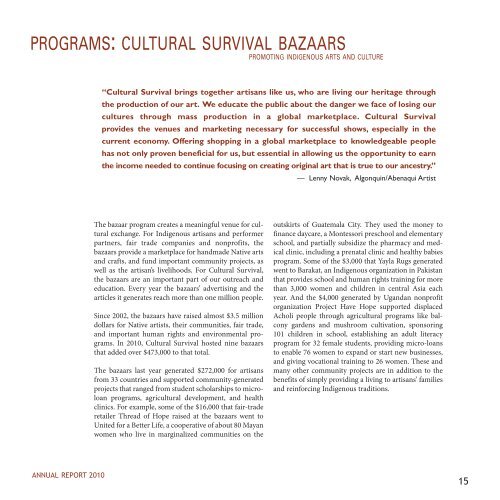Annual Report 2010 - Cultural Survival
Annual Report 2010 - Cultural Survival
Annual Report 2010 - Cultural Survival
Create successful ePaper yourself
Turn your PDF publications into a flip-book with our unique Google optimized e-Paper software.
PROGRAMS: CULTURAL SURVIVAL BAZAARS<br />
ANNUAL REPORT <strong>2010</strong><br />
“<strong>Cultural</strong> <strong>Survival</strong> brings together artisans like us, who are living our heritage through<br />
the production of our art. We educate the public about the danger we face of losing our<br />
cultures through mass production in a global marketplace. <strong>Cultural</strong> <strong>Survival</strong><br />
provides the venues and marketing necessary for successful shows, especially in the<br />
current economy. Offering shopping in a global marketplace to knowledgeable people<br />
has not only proven beneficial for us, but essential in allowing us the opportunity to earn<br />
the income needed to continue focusing on creating original art that is true to our ancestry.”<br />
— Lenny Novak, Algonquin/Abenaqui Artist<br />
The bazaar program creates a meaningful venue for cultural<br />
exchange. For Indigenous artisans and performer<br />
partners, fair trade companies and nonprofits, the<br />
bazaars provide a marketplace for handmade Native arts<br />
and crafts, and fund important community projects, as<br />
well as the artisan’s livelihoods. For <strong>Cultural</strong> <strong>Survival</strong>,<br />
the bazaars are an important part of our outreach and<br />
education. Every year the bazaars’ advertising and the<br />
articles it generates reach more than one million people.<br />
Since 2002, the bazaars have raised almost $3.5 million<br />
dollars for Native artists, their communities, fair trade,<br />
and important human rights and environmental programs.<br />
In <strong>2010</strong>, <strong>Cultural</strong> <strong>Survival</strong> hosted nine bazaars<br />
that added over $473,000 to that total.<br />
The bazaars last year generated $272,000 for artisans<br />
from 33 countries and supported community-generated<br />
projects that ranged from student scholarships to microloan<br />
programs, agricultural development, and health<br />
clinics. For example, some of the $16,000 that fair-trade<br />
retailer Thread of Hope raised at the bazaars went to<br />
United for a Better Life, a cooperative of about 80 Mayan<br />
women who live in marginalized communities on the<br />
PROMOTING INDIGENOUS ARTS AND CULTURE<br />
outskirts of Guatemala City. They used the money to<br />
finance daycare, a Montessori preschool and elementary<br />
school, and partially subsidize the pharmacy and medical<br />
clinic, including a prenatal clinic and healthy babies<br />
program. Some of the $3,000 that Yayla Rugs generated<br />
went to Barakat, an Indigenous organization in Pakistan<br />
that provides school and human rights training for more<br />
than 3,000 women and children in central Asia each<br />
year. And the $4,000 generated by Ugandan nonprofit<br />
organization Project Have Hope supported displaced<br />
Acholi people through agricultural programs like balcony<br />
gardens and mushroom cultivation, sponsoring<br />
101 children in school, establishing an adult literacy<br />
program for 32 female students, providing micro-loans<br />
to enable 76 women to expand or start new businesses,<br />
and giving vocational training to 26 women. These and<br />
many other community projects are in addition to the<br />
benefits of simply providing a living to artisans’ families<br />
and reinforcing Indigenous traditions.<br />
15


